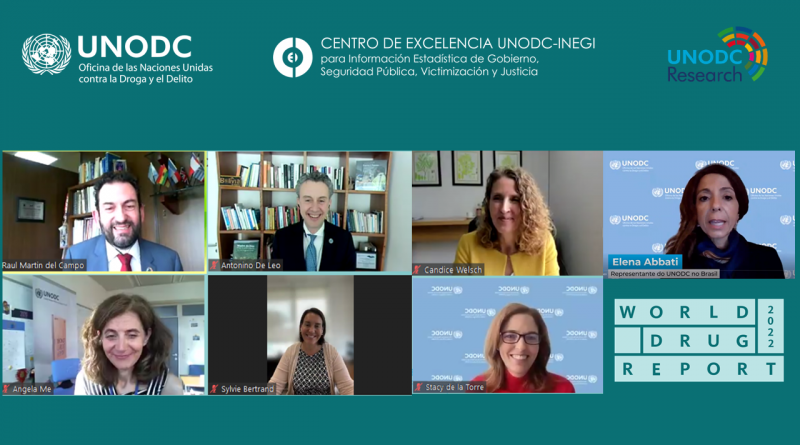What does the World Drug Report 2022 say about trends for Latin America and the Caribbean?
As every year, the United Nations Office on Drugs and Crime (UNODC) published the World Drug Report 2022. The UNODC-INEGI Center of Excellence in Statistical Information on Government, Crime, Victimization and Justice organized a webinar to present the report in Latin America and the Caribbean, in which Representatives of the region and the Chief of Research and Trend Analysis highlighted the main findings for the Americas. The webinar had almost 600 attendees and was moderated by Raúl Martín del Campo, from the National Institute of Psychiatry of Mexico.
Firstly, Sylvie Bertrand, Representative of the UNODC Regional Office for Central America and the Caribbean, mentioned disparities between women and men regarding drug use and treatment, gender specific vulnerabilities and the gender treatment gap. According to the report, women present higher rate use of non-medical use of sedatives and tranquilizers.
Antonino De Leo, Representative of the UNODC Office for Peru and Ecuador, highlighted the record level of cocaine manufacturing and the increase in its consumption. Although the area under coca bush cultivation remained stable, the cocaine production grew 11% between 2019 and 2020 reaching the historical record of 1,982 tons in 2020. Maritime trafficking is growing and nearly 90% of cocaine seized globally in 2021 was trafficked in containers and/or by sea. Major trafficking routes continue to flow from the Andes into North America and Europe, but data suggest that trafficking is also increasing levels to other regions like Africa and Asia.
Elena Abbati, Representative of UNODC Office of Brazil, presented the findings about the relationship between drugs and conflict. Data show that conflicts can interrupt and displace drug trafficking routes as was with the Balkans and more recently with Ukraine. The interrelationships between the fragility of the rule of law and conflict situations can offer opportunities for illicit drug trafficking.
Stacy de la Torre, Programme Coordinator from UNODC México, shared findings about amphetamine-type stimulants (ATS) markets, highlighting methamphetamine case in Mexico, where the number of persons in treatment due to methamphetamine increased 218% between 2013 and 2020. Mexico is the only country in the world where methamphetamine consumption is the main cause of treatments.
Candice Welsch, Representative of the UNODC Regional Office for Andean Countries and Southern Cone shared the novel contributions on the impact of illicit drugs on the environment. The analytical framework for drugs and the environment considers drug use and drug supply as well as the responses to the drug problem in five areas: deforestation, air pollution, energy consumption, soil pollution and depletion and, water pollution and depletion.
To finish, Angela Me, Chief of the UNODC Research and Analysis Trend Branch, remarked the importance of differentiation among decriminalization, legalization and depenalization. It is still not possible to know if the effects are caused by legalization, but where cannabis was legalized data show increase of consumption and decrease of risk perception, particularly more daily consumption but not monthly and annual. Despite the cannabis legalization, there is a parallel illegal market of cannabis.
The World Drug Report 2022 is available in the following link: https://bit.ly/3xXrjlN
This Webinar is available at the UNODC You Tube Channel in the following link: https://www.youtube.com/watch?v=_Fhoyc437wU



